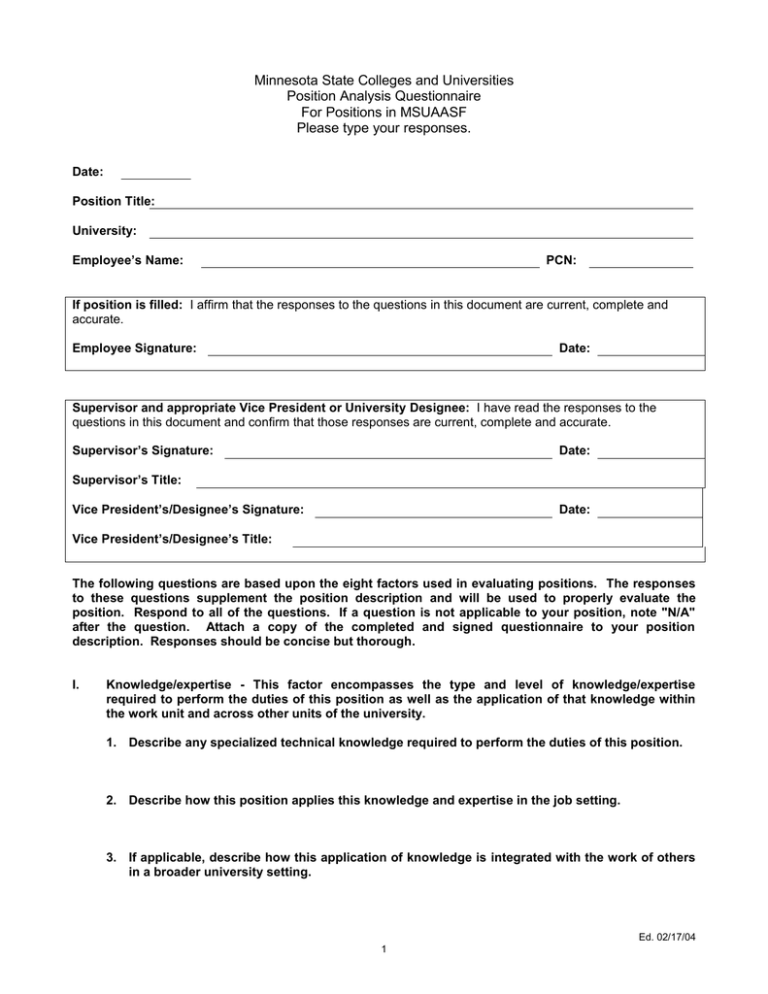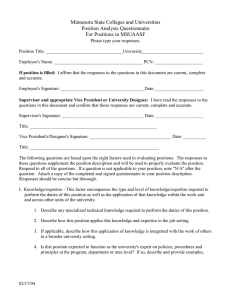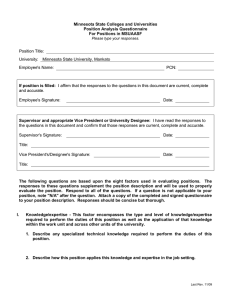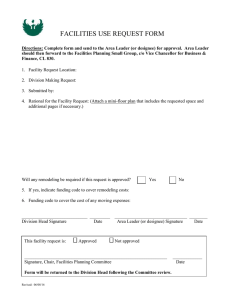Minnesota State Colleges and Universities Position Analysis Questionnaire For Positions in MSUAASF
advertisement

Minnesota State Colleges and Universities Position Analysis Questionnaire For Positions in MSUAASF Please type your responses. Date: Position Title: University: Employee’s Name: PCN: If position is filled: I affirm that the responses to the questions in this document are current, complete and accurate. Employee Signature: Date: Supervisor and appropriate Vice President or University Designee: I have read the responses to the questions in this document and confirm that those responses are current, complete and accurate. Supervisor’s Signature: Date: Supervisor’s Title: Vice President’s/Designee’s Signature: Date: Vice President’s/Designee’s Title: The following questions are based upon the eight factors used in evaluating positions. The responses to these questions supplement the position description and will be used to properly evaluate the position. Respond to all of the questions. If a question is not applicable to your position, note "N/A" after the question. Attach a copy of the completed and signed questionnaire to your position description. Responses should be concise but thorough. I. Knowledge/expertise - This factor encompasses the type and level of knowledge/expertise required to perform the duties of this position as well as the application of that knowledge within the work unit and across other units of the university. 1. Describe any specialized technical knowledge required to perform the duties of this position. 2. Describe how this position applies this knowledge and expertise in the job setting. 3. If applicable, describe how this application of knowledge is integrated with the work of others in a broader university setting. Ed. 02/17/04 1 4. Is this position expected to function as the university's expert on policies, procedures and principles at the program, department or area level? If so, describe and provide examples. II. Innovative Thinking - This factor addresses the use of innovative thinking to address issues in the work setting. 1. Describe the issues this position must frequently address, and the scope and nature of these issues. 2. Describe the authority this position has to resolve these issues. 3. Provide examples of innovative responses to issues that have been presented. III. Strategic Planning and Assessment - This factor addresses the role this position plays in short and long range planning and its involvement in assessment of results against those plans. Responses to the following questions might describe more than one role and must identify the organizational level at which the position operates in each role. 1. Describe this position's role in the short and long range planning processes. 2. Describe this position's role in assessing results against the short and long range plans. IV. Policies, Procedures, Laws and Regulations - This factor describes the relationship of this position to institutional policies and procedures as well as with the laws and regulations of entities external to the university. 1. Describe how the position is constrained by state and federal law, or local ordinance. 2. Describe the role of this position in development and implementation of policies, procedures and precedents, including identification of the organizational level at which this role is played. 3. How does this position impact the development or interpretation of laws and regulations of external entities? Identify these external entities. V. Decision making, accountability and impact - This factor addresses typical decisions made by this position and the impact of those decisions on the work unit and the university. Ed. 02/17/04 2 1. Describe the decisions typically made by this position. 2. What input is this position expected to solicit from other parties before making these decisions? 3. Identify the specific groups affected by these decisions. VI. Resource Management - This factor addresses the position's responsibility for managing facilities, money (including salary budgets), technology, equipment and supplies, but does not include people. 1. What resources are managed? 2. What level of discretion does the position have in using these resources? 3. What is the impact of the decisions made with respect to the use of resources? 4. If applicable, discuss the position's responsibility for generation of revenue for the university. VII. Leadership and Management - This factor addresses the role the position plays in the development and implementation of work plans and responsibility for directing the work of others. 1. Does this position have responsibility for personnel decisions? If so, place check marks in the applicable boxes in the following check list. Activity For State Employees Participate Make final Make final in process. recommendation. decision. * For Student Employees Participate Make final Make final in process. recommendation. decision. * Hiring Transfer Suspend Promote Terminate Assign work Reward Discipline Adjust Grievances * Higher authority may sign papers, but the decision is made by the person in this position. 2. Identify specific positions or groups that are given work direction by this position. Ed. 02/17/04 3 3. For each group identified above, describe the nature of the work direction, setting of priorities and technical direction. 4. If applicable, describe the position's responsibility for developing and/or implementing work plans, other than the daily work plan, e.g. annual/quarterly work plan, or project plan. VIII. Communications and Relationships - This factor addresses the scope and nature of communications with co-workers, students and other clientele. 1. Identify individuals and groups that this position is expected to communicate with and develop working relationships with (e.g. university/department committees, president, vice-presidents and deans, university faculty and staff, alumni, donors, vendors, special community groups, parents, state and federal agencies, etc.). 2. Describe the nature and purpose of communications with these groups. Examples of the purpose of these communications include providing or collecting information; communicating concepts or ideas; persuading others; negotiating with others; and influencing opinions. Is there any additional information that you believe would be useful in the evaluation of this position? Ed. 02/17/04 4



